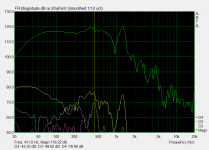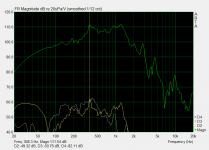Thanks, IB18HT-PRO works marginally better for me. Lighter cone should make for a better high end, too.
I keep plugging this series of drivers, but the Alpine Type R and Type S are hard to beat.
I have an Alpine Type S here that has a 15" cone, lower qts than the ubiquitous SI HT, and I paid a whopping $135 delivered to my door. Because these woofers are so common, it shipped from a store just ninety miles away and arrived in under two days.
Really nice build quality. The Type S is underhung and the Type R uses an aluminum demodulation ring.
I agree they are nice drivers, especially for the money, but you aren't suggesting we use alpine type R up to 500 Hz for me or 1 Khz for Charlie, are you?
... But this also depends on how susceptible the magnet material is to modulation by the voice coil current, and it turns out that rare earth magnets like Nd alloys are much less susceptible by almost 20 times...
Hi Charlie, do you have a citation for this?
I first saw this claimed by Thomas Dunker and I have wanted to clarify it ever since, because the B / H data does not support the claim, AFAIK.
Or perhaps I misunderstand your point, Nd materials do have the benefit of better conductivity and hence act as an inherent shorted turn to reduce flux modulation.
Do you mean this effect only?
Best wishes
David
Hi Charlie, do you have a citation for this?
I first saw this claimed by Thomas Dunker and I have wanted to clarify it ever since, because the B / H data does not support the claim, AFAIK.
Or perhaps I misunderstand your point, Nd materials do have the benefit of better conductivity and hence act as an inherent shorted turn to reduce flux modulation.
Do you mean this effect only?
Best wishes
David
Can't recall where I "learned" this factoid, but it wasn't in a scientific journal so take it for what it is.
The section "3. Transducer magnetic circuit linearity" on Page 4 of this JBL tech note (Volume 1, Number 33) gives some supporting info:
https://www.jblpro.com/pub/technote/JBL_TN 1-33 rev3.pdf
I can't say whether this can be applied across the board, or not.
Here's a less expensive option: a gently used JBL 2241H. Specs here:
https://www.jblpro.com/pages/pub/components/2241.pdf
These seem to be selling on Ebay for $150+shipping. Many available.
This would let me experiment before I commit to a more expensive new driver. The 2241H isn't bad itself!
Should I get one to try out?
https://www.jblpro.com/pages/pub/components/2241.pdf
These seem to be selling on Ebay for $150+shipping. Many available.
This would let me experiment before I commit to a more expensive new driver. The 2241H isn't bad itself!
Should I get one to try out?
tubejunkie was mentioned as good seller.These seem to be selling on Ebay for $150+shipping.
Doh, maybe I should first consider what I already have in-hand: a pair of unused Peavey Low Rider 18.
What has been stopping me from doing this before is (A) specs say max 500Hz and (B) I have a faint recollection that I measured the drivers and found some odd resonance or distortion issues (dustcap?) between 500Hz and 1kHz. I can't find the data, so I'm not sure at the moment.
I should drag these out tomorrow and re-measure. Le is pretty low at 0.87mH.
I will post the results when I have them.
What has been stopping me from doing this before is (A) specs say max 500Hz and (B) I have a faint recollection that I measured the drivers and found some odd resonance or distortion issues (dustcap?) between 500Hz and 1kHz. I can't find the data, so I'm not sure at the moment.
I should drag these out tomorrow and re-measure. Le is pretty low at 0.87mH.
I will post the results when I have them.
Hey Charlie, didn't you ever hear John Bush's "Big Boy" 18 in. P.Audio coax speakers?
Super dynamic speakers. Those are from the Blue Monster series.
We got into trouble with those at RMAF. 😀
Super dynamic speakers. Those are from the Blue Monster series.
We got into trouble with those at RMAF. 😀
Out of interest, where did you get the 4" fullrangers from ?
Interested myself in these.
cheers
blakkshepe
A local company, (Cannonsound in Sydney, Australia) ships in P-Audio stuff. I think they get a shipping container every few months. I have purchased stuff from them a handful of times. They got four of these drivers (SN4-60F) in for me:
P.Audio System Co., LTD
Three measure close to spec, and are within 1 or 2% of each other. The average of these is:
5.897 Re (spec = 5.9)
105.4 Fs (spec is 112)
0.3763 Qts (spec is 0.41)
0.492 Qes (spec is 0.53)
1.602 Qms (spec is 1.69)
0.2077 Le(10kHz) (spec is 0.12 but measured at 1kHz)
5.15 Mms (g)
2.527 Vas (litres)
89.65 SPL(1W/1m) (spec is 90)
...and the anomaly:
5.651 Re
105.7 Fs
0.595 Qts
0.8606 Qes
1.928 Qms
0.2025 Le(10kHz)
5.146 Mms (g)
2.506 Vas (litres)
87.25 SPL(1W/1m)
The SN4-60F sounds pretty good. I've measured them against Fostex FF105WK and about a dozen random small drivers (Sony, Sharp etc), and it is either flatter or more extended than all of them.
A driver that seems overall similar but with better specs (for power etc) is the PRV 5MR450-NDY. About double the price, but still pretty affordable / possibly worth the extra... and possibly with better manufacturing consistency.
The 18FH500 looks like a good candidate for an 18" two way crossed at 700-800hz. Maybe to the LTH142 horn.
The 18FH500 looks like a good candidate for an 18" two way crossed at 700-800hz. Maybe to the LTH142 horn.
I was hoping to cross over very steeply (using active, DSP) 1kHz because of the horn cutoff. I could go with a slightly larger horn and cross at 900Hz. With the 18FH500 this would be the best solution I think.
Does anyone have some thoughts on those used JBL 2241H's?
Peavey Low Rider 18 measurements
OK, I did a couple of quickie frequency response and distortion measurements on one of the Peavey Low Rider 18s that I have in hand. These were better than I was expecting, and probably about as good as a middle of the pack 18 that you can get new today.
See attached screen shots. I did three measurements with the driver aimed up, supported, but unbaffled. The "nearfield" was done with the mic about 1in from the dustcap, the next about 8 inches away (just slightly outside of the frame) and finally about 2 feet away. The nearfield has a null at around 800Hz or so that is due to the technique itself. You can see that this disappears as you move away from the cone a bit.
Distortion is nothing special. I tried to put the cursor on "bad" spots. These are still below -40dB (1%) so I think I can live with it for testing purposes.
The frequency response seems to make it to 1kHz. I don't see anything horrible in the distortion spectrum to suggest a terrible breakup up to that frequency, or above. There is no doubt some dustcap resonance/breakup (peaks around 350Hz-450Hz) and other lovelies going on, but if they are well controlled who cares at this stage.
So I may just use these along with my SEOS-12 horn and see how it goes, building a one-off single speaker to test out the idea. I can always "upgrade" to better drivers, a larger horn, etc. later on down the road if I am happy with the first pass. At this point I don't see the need to throw down several hundred dollars on a different 18.
OK, I did a couple of quickie frequency response and distortion measurements on one of the Peavey Low Rider 18s that I have in hand. These were better than I was expecting, and probably about as good as a middle of the pack 18 that you can get new today.
See attached screen shots. I did three measurements with the driver aimed up, supported, but unbaffled. The "nearfield" was done with the mic about 1in from the dustcap, the next about 8 inches away (just slightly outside of the frame) and finally about 2 feet away. The nearfield has a null at around 800Hz or so that is due to the technique itself. You can see that this disappears as you move away from the cone a bit.
Distortion is nothing special. I tried to put the cursor on "bad" spots. These are still below -40dB (1%) so I think I can live with it for testing purposes.
The frequency response seems to make it to 1kHz. I don't see anything horrible in the distortion spectrum to suggest a terrible breakup up to that frequency, or above. There is no doubt some dustcap resonance/breakup (peaks around 350Hz-450Hz) and other lovelies going on, but if they are well controlled who cares at this stage.
So I may just use these along with my SEOS-12 horn and see how it goes, building a one-off single speaker to test out the idea. I can always "upgrade" to better drivers, a larger horn, etc. later on down the road if I am happy with the first pass. At this point I don't see the need to throw down several hundred dollars on a different 18.
Attachments
No, these look like they'll work just nicely for a price that you've already afforded. 🙂
I'm just wondering how you *forget* you had a set of 18" drivers hanging around! 😛
I'm just wondering how you *forget* you had a set of 18" drivers hanging around! 😛
A SEOS24 would cross nicely to these. 🙂
This is true. I was actually offered a pair by someone recently, and I thought about it, but I would need to invest in the horns AND drivers, which are 1.4/1.5" type and are not cheap.
Since I already have the SEOS-12 and DNA-360 I might as well try them. My cabinets will be rather short and wide so I can locate the woofer and horn on the baffle so that if I want/need to use a larger horn I can simply open up the hole.
Ah, cool. I have bought P-Audio from them before also (including the legendary BM15-CX38) but it never occurred to me to place a special order. What was the MOQ for your drivers ?A local company, (Cannonsound in Sydney, Australia) ships in P-Audio stuff. I think they get a shipping container every few months. I have purchased stuff from them a handful of times. They got four of these drivers (SN4-60F) in for me:
P.Audio System Co., LTD
snippety doo dah
I would be interested in getting some of the newer, smaller coaxes if the MOQ is reasonable, or maybe get a group buy going.
cheers,
blakkshepe
Can't recall where I "learned" this factoid, but it wasn't in a scientific journal so take it for what it is.
It is incorrect I think.
The section "3. Transducer magnetic circuit linearity" on Page 4 of this JBL tech note (Volume 1, Number 33)... https://www.jblpro.com/pub/technote/JBL_TN%201-33%20rev3.pdf
Reason I was slow to reply was because I wanted to compare this with an earlier JBL Technical Note (Volume 1, Number 23).
They both appear to be incorrect or deceptive, sometimes in different ways.
JBL is not usually stupid so I don't know if this is deliberate misinformation for competitors, written by a clueless intern while the real experts work on actual speakers, or a slip by someone who should know better.
Anyone know a reference on loudspeaker transducers that covers this?
Best wishes
David
- Status
- Not open for further replies.
- Home
- Loudspeakers
- Multi-Way
- P Audio P180/2242 18" pro driver - worth a try?


